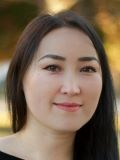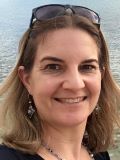|

Svetlana Koltovskaia
|
|

Betsy Gilliland
|
Svetlana: Could you tell us about when and how you got into the field of SLW?
Betsy: It was in 2001 when I got a job at San José State University in California at the end of March. A composition teacher was on sick leave, so they told me “here is a class with multilingual students who need to learn how to write before the end of the semester.” I kind of got thrown in at the deep end. In my M.A. TESOL program, we just had a four-skills class, so I never really learned how to teach writing. And then suddenly, I had to teach multilingual students how to write for college purposes. So I started going to conferences and attending every session I could find about writing. Then eventually I realized it was what I really was interested in. I worked with students who were born in other countries, but mostly, my students were local students who grew up near San José and went to school in the US. Yet, writing still was a challenge for them. You could see that there were traces of other language influences. That made me interested in Dana Ferris’s work, particularly around responding to writing.
Svetlana: Could you tell us what kind of research you do?
Betsy: I'm really interested in the local resident, multilingual students, like the ones I was teaching in San José. My dissertation was on such students and their experiences in high school. I have done a couple of projects in Hawaiʻi also looking at local high school, multilingual writers. My other research interest is in how language teachers learn to teach writing. I've been working the last couple of years on a project with the University of Hawaiʻi English Language Institute (ELI) writing teachers who are all graduate students in our department to see if we can put small group writing conferences into place. The idea is trying to get the best of peer review and writing teacher-student conferences while improving on both of them.
Svetlana: What person or experience has had the greatest impact on your research/career?
Betsy: Dana Ferris’s work has definitely had a big impact because I like that she is also always thinking about the teacher: what does this mean for writing teachers? I think there is a lot of research that looks at very refined things such as we need to understand this or that. But when you read a lot of them you want to know how that works when we are actually teaching.
Svetlana: What is the biggest issue or challenge in the field, as you see it?
Betsy: This is actually part of my interest in teacher research and how teachers learn to teach. There is a disconnect between teaching and research. Teachers often want to do research, but they may not have the support to get feedback on what they are doing or to understand how to design a study from the beginning. Editing the Journal of Response to Writing, we get some articles, and I have seen these when I review for other journals, too, where it is a good idea but the person clearly did not think about it as research from the beginning. It is after the fact, so there is not this systematic process. I think that there has been some work about how it would be really useful for teachers to have ongoing mentorship. In language teacher research in general, people like Anne Burns in Australia are doing that. But I do not know that we have anybody in L2 writing, specifically, working with in-service teachers as they are doing research.
Svetlana: How has the pandemic affected/shaped your research/work?
Betsy: The project I mentioned about working with the ELI teachers was entirely pandemic driven. I had been reading work about group conferences, and those were all done in in-person settings: the teacher and the student sit in a room together. When the pandemic started, I was thinking that Zoom would be a perfect platform for this because you can do screen sharing alongside talking. So I thought that maybe one of the ELI teachers would be interested. I reached out to all of the graduate students that were teaching writing, and they liked the idea. In the summer before the fall 2020 semester, we figured out all of our protocols and set it all up and got IRB permission. Then the teachers did conferences in their classes. In the spring semester, we did it again. We collected more data and we brought in one more graduate student who had started teaching in the ELI. Then we analyzed the data and did a colloquium at AAAL and a panel at TESOL, and people seemed really interested. We are working now on trying to figure out how to break it up into journal articles.
Svetlana: Could you tell us about what you are presently working on and what inspired you to undertake this research/work?
Betsy: In terms of research, I am not starting any new projects right now. I'm just continuing to work with the writing teachers and on a project with high school students in Hawaiʻi. There is also a book about EFL writing teacher education I am working on with Lisya Seloni, Sarah Henderson Lee, Tanita Saenkhum, and Estela Ene that hopefully will come out in early spring next year. I hope it will be out before the TESOL conference. The book is an edited volume of EFL writing teacher preparation focused particularly on underrepresented areas, because what we were realizing is that there is information about writing teacher education, but it is coming from a few scholars in a few places. And so we wanted to hear from people in other countries in other contexts. And so we were able to find a few authors in Africa and several in South America and then others in Asia and Europe. The book has three sections. One section is called “state of the field,” which contains traditional research articles. The section looks at how EFL teachers learn to teach writing, because it seems, for the most part, there are no specialized writing teachers. Almost everywhere, language teachers happen to teach writing. Another section is called “voices from the field,” which is a bit more of a personal reflection format. The section looks at what the actual teachers and teacher educators say about teaching writing or preparing teachers to teach writing. And then the last section is called “resources,” and it includes actual activities and lesson plans and units and things that other people might be able to make use of in their contexts. I have really enjoyed working on the book. Some of it is a challenge because we work with people who have not had a lot of publishing experience to be writing chapters. So we do a lot of coaching as we are reviewing the manuscript, but it is shaping up nicely.
As for inspiration, all five of us have been doing work in other countries, so we have seen what it is like in places where second language writing is not as common. One of the interesting things I learned when I was in South America is that there is a vibrant writing and rhetoric community. The thing is that their meetings and publications are mostly in Spanish and Portuguese. And so the English-language academic world does not read what they write. So what we need is more cross communication for the people in North America to read what is being written in South America and for people in South America to be able to get their message to people in North America.
Svetlana: Could you share some of the most interesting findings from your recent research?
Betsy: My book edited with Maryl Siegal titled Empowering the Community College First-Year Composition Teacher came out last year with University of Michigan Press. One of the things I really like about that book is it brings together first and second language writing with the common thread being community college: ways of teaching writing to community college students. There is a great chapter there about Korean international students, something I had not really even thought about. But now that I look back at my students in Hawaiʻi, I have a lot of international students who started at the community college. So there is that population, there are resident multilingual learners, there are students who don’t think of themselves as multilingual, but they speak more than one language. They may not even be in second language writing classes. And yet there are language things that all college writers need to learn. So I think an exciting direction that second language writing should go more into is looking at the students outside of our research universities.
Svetlana: As an expert in the field of SLW who has done extensive research and service for the field and community, what would you recommend for someone who wants to develop expertise in SLW?
Betsy: I would say definitely think about the teachers. So it is important to make sure that whatever research you are doing you are seeing it holistically. It is not just a linguistic phenomenon that you are studying, there are people involved, the students and the teachers. You want to think about how this looks in actual classrooms or real contexts for the learners and the teachers.
Svetlana: Thank you!
Svetlana Koltovskaia is an Assistant Professor of English and director of ESL Academy at Northeastern State University, Tahlequah, Oklahoma. Her research centers around L2 writing, computer-assisted language learning, and L2 assessment.
Betsy Gilliland is an associate professor in the department of Second Language Studies at the University of Hawaiʻi Mānoa. She teaches courses in second language writing and language teacher research and regularly leads graduate students on a teaching practicum in Thailand. She is co-editor of the open-access Journal of Response to Writing and on the editorial boards of the Journal of Second Language Writing, Journal of Language, Identity, and Education, and TESL-EJ. |

